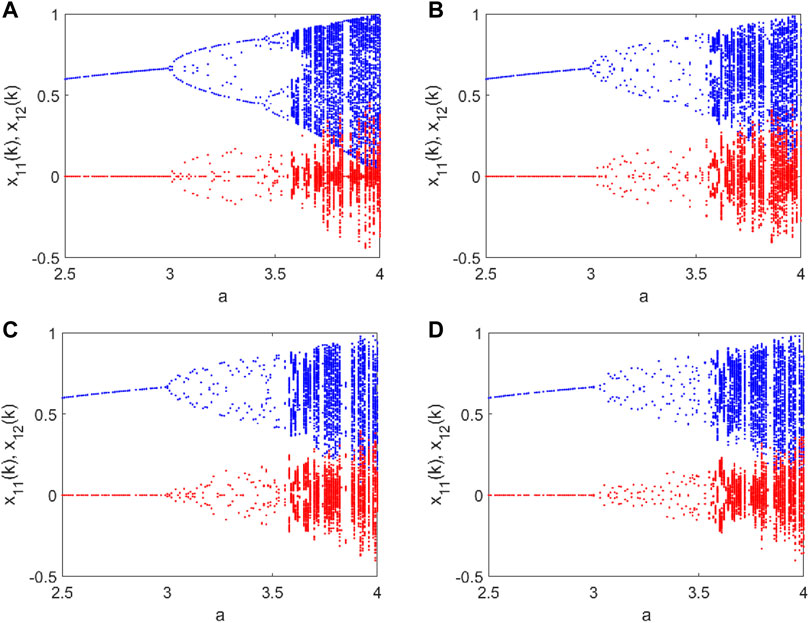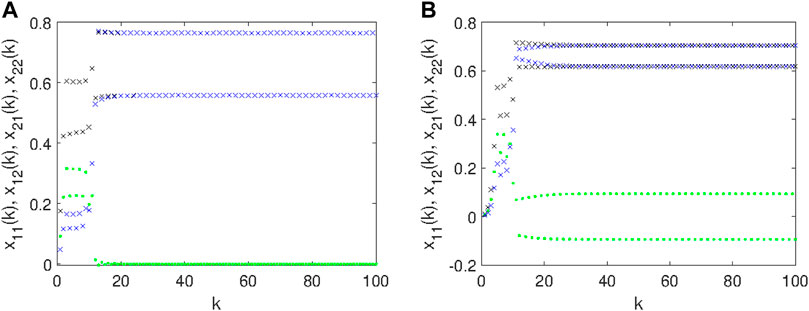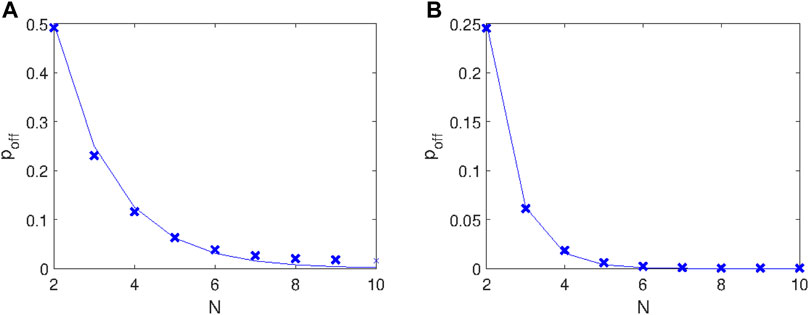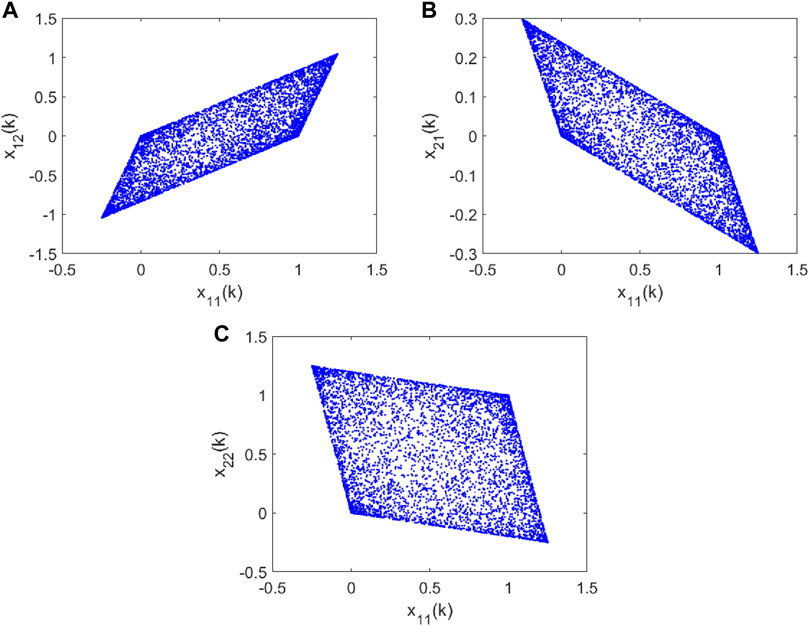- 1Dipartimento di Ingegneria Elettrica Elettronica e Informatica, University of Catania, Catania, Italy
- 2IASI, Consiglio Nazionale Delle Ricerche (CNR), Roma, Italy
In this paper, the general concept of multidimensional discrete maps is presented. Moreover, new and fundamental results show the invariance of the bifurcation points from periodic to chaotic behavior. Numerical examples regarding the multidimensional cases of the logistic map, the complex-valued Ikeda map, and the multivariable Henon map are reported.
1 Introduction
The role of iterative nonlinear maps has been fundamental both regarding the possibility to explain complex nonlinear dynamics and their elegant attractors in more detail [1, 2] and regarding their practical applications [3–6]. In fact, in [5, 6], the possibility of using logistic maps to make computations and the actual, timely use of them to generate secure code numbers are discussed. Discrete maps are easily handled by computers and can be processed by powerful available microcontrollers. Therefore, today, their use in less expensive applications is becoming possible starting from the previous considerations. As an example, chaos computing is a timely topic as it consists in using chaotic systems for computation. In particular, chaotic discrete-time systems can be designed to reproduce all types of logic gates [7–9]. This suggests the actual interest in exploring iterative maps for real-world advanced applications.
It is, therefore, of particular interest to discover new high-dimensional iterative chaotic maps. Under this perspective, the idea that is proposed in this contribution is the introduction of multidimensional discrete maps. The term “multidimensional” must not be considered as the classical multidimensional systems theory [10] in this context, but rather refers to the cases discussed in previous works [11, 12], where a two-dimensional matrix logistic map has been reported, discussing the not-explosivity condition referred to the choice of the initial conditions. Besides these results, the intriguing topic of multidimensional chaotic maps is quite absent in the literature.
Referring to this class of systems, a particular property regarding the so-called bifurcation parameter invariance is shown in this contribution. This means that the bifurcation points are invariants in the multidimensional system with respect to the scalar one. Moreover based on some combinatory considerations, the concept of “almost similarity” of the bifurcation diagrams, in periodic windows, is introduced.
The paper is organized as follows. In Section 2, the main concepts of iterative maps are reported also including some mathematical preliminaries. The core of the paper is concentrated in Section 3, where the main definitions and facts regarding the multidimensional nonlinear maps are dealt with. In order to clearly explain the concepts included in the previous section, extensive numerical results are reported in Section 4, even if the theory is quite general, the numerical results are related to the logistic map, the Ikeda map, and the Henon map. The conclusive Section 5 will draw a summary of the presented results and defines the perspectives of the research.
2 Iterative Maps and Mathematical Preliminaries
Definition 1. An iterative 1D discrete map is defined as a map of the form
Where
Of course, if
Definition 2. The 1D discrete map:
where
The behavior of the logistic map (2) is synthesized thanks to the bifurcation diagram reported in Figure 1.

FIGURE 1. Bifurcation diagram of the logistic map in Eq. 2 with respect to a.
The logistic map represents the easiest map with the stereotyped behavior of a complex system [1].
The bifurcation diagram includes, by varying the parameter a, fixed points, oscillatory behavior, intermittency, and chaos. The various studies about logistic 1D maps make us consider them both as a reference example for further study in discrete maps and a paradigm of complex behavior to take into account in more complex continuous-time systems. Moreover, it is literature, it is considered a reference point in the generation of complex lattices by coupling more logistic maps [13].
Due to the importance of the logistic map, attention is devoted in particular to the case of multidimensional discrete maps generated by the logistic map. In the literature, in fact, attention has been devoted to the iterative logistic map of matrices [11, 12] for matrices belonging to
Definition 3. The complex-valued Ikeda map is represented by the following equation:
where
It is also considered an analytic function in the complex domain of the logistic map. The onset of chaos can be observed by varying the parameter p, while fixing B = 0.76, ρ = 0.4, and a = 6, as shown in the bifurcation diagram reported in Figure 2.

FIGURE 2. Bifurcation diagram of the Ikeda map in Eq. 3 with respect to p. Other parameters: B = 0.76, ρ = 0.4, and a = 6.
Definition 4. The Henon map is a two-variable nonlinear map described by the following equations:
where

FIGURE 3. Bifurcation diagram of the Henon map in Eq. 4 with respect to a. Other parameters: b = 0.3.
3 Multidimensional Nonlinear Discrete Maps
Let us consider the scalar 1D map in Eq. 2. If, instead of x being a scalar, a matrix
which is called a multidimensional discrete map. Therefore, the matrix
contains N × N elements which vary according to the function F.
Moreover, the concept is generalized to the case of mD maps, i.e., maps with more variables. In fact, in this case, F is a function whose arguments are instead of the scalars x1, x2, and xm, respectively the matrices X1, X2, and Xm, each belonging to the set
Easily speaking the multidimensional map is generated by a scalar iterative maps where, instead of the original scalar variable, square matrices are considered. Moreover, if the function f is analytic, the multidimensional iterative map achieves particular properties.
Definition 5. An iterative map is said to be explosive if it does occur
being ‖⋅‖ a matrix norm if the map is multidimensional, the Euclidean norm if it is considered an mD map, the absolute value if a 1D map is considered.
Theorem 1. The iterative multidimensional map is not explosive if the matrix X(0) has eigenvalues belonging to the basin of attraction of the scalar map f with an analytic function.Proof. In fact, let x(0) be in the basin of attraction of f being
Let us consider the corresponding multidimensional map defined as
with X(0) = TXD(0)T−1, XD(0) being a diagonal matrix containing the eigenvalues of X(0), and
due to the fact that F is analytic and therefore with the peculiarity to be expressed in a polynomial form, it does result in
where FD is a diagonal matrix made by N maps fi(α, xi(k)), with xi(0) = XD(i, i) and i = 1, … , N.Therefore, from the last consideration, if the eigenvalues of X(0) that include the quantities XD(i, i) are chosen in the basin of attraction of f, the multidimensional map is not explosive. □.Example. Let us consider the logistic map
The associated multidimensional map is given by
Let X(0) = TXD(0)T−1, we have
It is therefore
which is a diagonal matrix where each term represents the scalar map (12). Therefore, if each λi = XD(i, i) belongs to the interval
Theorem 2. Let us consider the multidimensional map as previously defined and the relationship (11). If the map is not explosive, under the conditions given in Theorem 1, the multidimensional map related to it assumes for each variable a chaotic behavior exactly at the same parameter values.Proof. We are guaranteed that each term of the diagonal matrix FD has a diagonal trend. The real trend of X(k + 1) is therefore the linear combination of the n chaotic signal by the matrices T and T−1 and therefore the general matrix is made by n2 chaotic signals [16]. □Remark 1. Let us consider a multidimensional iterative map of dimension N × N. Assuming the same conditions of Theorem 1, the bifurcation diagram is almost equal to that of the generating map as regards the entire bifurcation route to chaos.
4 Numerical Results
In this section, numerical investigations on the behavior of multidimensional chaotic maps are reported. We will consider the paradigmatic case of the logistic map and the cases of the two-dimensional Henon map and the complex-valued Ikeda map. In the following, without lack of generality, initial conditions are chosen as symmetric matrices; similar results can be gained with non-symmetrical initial conditions.
4.1 Logistic Map
The multidimensional logistic map is described by
where

FIGURE 4. Bifurcation diagram of the multidimensional logistic map in Eq. 16 with respect to a: (A) N = 2; (B) N = 3; (C) N = 4; and (D) N = 5.
The different behavior of the branches in the periodic windows is due to the role of initial conditions. Let us consider the period-2 window, fixing parameter a = 3.1. Two possible behaviors can arise as the maps in the diagonal of X can show an in-phase period-2 or a counter-phase period-2. This leads to the two plots reported in Figure 5. As it can be seen, in the first case, the off-diagonal maps converge to zero since the two contributions of the diagonal map make the off-diagonal map converge.

FIGURE 5. Different periodic behavior of the multidimensional logistic map in Eq. 16 with N = 2 and a = 3.1: (A) In-phase periodicity of the diagonal maps x11(k) and x22(k) leading to convergent off-diagonal maps x12(k) and x21(k); (B) anti-phase periodicity of the diagonal maps x11(k) and x22(k) leading to period-2 behavior also in the off-diagonal maps x12(k) and x21(k).
A similar condition occurs for the period-4 window, fixing a = 3.5, as four possible behaviors emerges with one leading to off-diagonal maps converging to zero, as reported in Figure 6.

FIGURE 6. Different periodic behavior of the multidimensional logistic map in Eq. 16 with N = 2 and a = 3.5: (A) In-phase periodicity of the diagonal maps x11(k) and x22(k) leading to convergent off-diagonal maps x12(k) and x21(k); (B–D) not in-phase periodicity of the diagonal maps x11(k) and x22(k) leading to period-4 behavior also in the off-diagonal maps x12(k) and x21(k).
This allows us to determine the probability of having off-diagonal maps converging to zero as

FIGURE 7. Probability of having off-diagonal maps converging to zero in the multidimensional logistic map with N = 2: (A) Period-2 window (r = 2); (B) period-4 window (r = 4). The continuous lines refer to the exact formula
It appears evident that the initial conditions play a crucial role in multidimensional maps, also when the global behavior is periodic. Thus a strong multi-stable behavior is elicited by the multidimensionality of the system. In Figure 8, we reported the bifurcation diagram for N = 4 limited to the period-2 window for 100 different initial conditions. As can be observed, the two branches of the scalar logistic map enclose all the admissible periodic states. The initial conditions, thus, also play a role in the amplitude of the observed states. We remark also that the symmetry of the matrix X(0), chosen as initial conditions, leads to synchronized symmetric off-diagonal variables, as derived directly from Theorem 1.

FIGURE 8. Bifurcation diagram of the multidimensional logistic map in Eq. 16 with respect to a, for N = 4, in the period-2 window. Points represent the steady state for 100 different realizations for each value of a.
We remark that the invariance of the bifurcation points is independent from N, as expressed by Theorem 2. Therefore, considering a multidimensional map with a higher values of N, we observe that the bifurcation diagram maintains the bifurcation points of the scalar map, as shown in Figure 9, where the bifurcation diagram for N = 100 and N = 1 are compared in the parameter range

FIGURE 9. Invariance of the bifurcation points for higher values of N: (A) Bifurcation diagram for the multidimensional logistic map with N = 100; (B) bifurcation diagram for the scalar logistic map. Diagrams are evaluated with respect to
The parameter range

FIGURE 10. Chaotic bursting in the intermittent behavior of x11 shown by the multidimensional logistic map with N = 100 for
4.2 Ikeda Map
Let us consider the multidimensional extension of the Ikeda map as:
where

FIGURE 11. Bifurcation diagram of the multidimensional Ikeda map in Eq. 17 with respect to p: (A) N = 2; (B) N = 3. Other parameters: B = 0.76, ρ = 0.4, and a = 6.
4.3 Henon Map
Let us consider the multidimensional Henon map as
where

FIGURE 12. Bifurcation diagram of the multidimensional Henon map in Eq. 18 with respect to a: (A) N = 2 and X(0) and Y(0) with the same eigenvector set; (B) N = 2 and X(0) and Y(0) with different eigenvectors. Other parameters: b = 0.3.
5 Conclusions
The multidimensional maps allow us to directly interconnect more signals with similar characteristics. In particular, this aspect is evident referring to the consideration related to the chaotic behavior remarked in the bifurcation diagrams. Moreover, the definition of almost similar bifurcation diagrams gives us strong assurances that the same bifurcation points are observed for the periodic behavior of the multidimensional maps.
The interest in further considering multidimensional maps is also motivated by the fact that nonlinear discrete maps with a higher number of variables are less frequent in literature with respect to scalar discrete maps. The possibility to build matrix-based high-order chaotic systems in discrete-time domain is therefore opened with this paper. This means considering a low-order dynamical system as a gene. From it, the use of matrices instead of scalar state variables should be considered. Even if in the discrete case that a chaotic map is generated from a multidimensional system with the same strange characteristics, in the case of continuous-time multidimensional systems, it is conjectured that hyperchaotic behavior arises.
From an application point of view, the multidimensional discrete maps will be very useful in encryption systems generating instead of one scalar quantity, N2 signals that can be changed in real-time varying the multidimensional size. For these applications, a physical implementation of multidimensional maps must be taken into account. An analog implementation is not convenient since it includes more couplings and the use of several analog multipliers. Indeed, the difficulties of the practical realization of the logistic map with analog components discussed in previous work [17] are further amplified. For these reasons, to obtain a straightforward, flexible, and reliable implementation, a digital approach based on microcontrollers or hybrid analog/digital solutions [3] is preferable.
Regarding the Lyapunov exponents, a direct correlation does not exist between the gene scalar map and the corresponding multidimensional map. In fact, in the multidimensional maps, the increase of the variables leads to the use of standard algorithms for computing Lyapunov exponents that are highly computationally demanding. Moreover, from our experiments we can conjecture that the maximum Lyapunov exponent of the multidimensional case is always greater than that of the generating scalar or multivariable map.
The multidimensional maps introduced in this paper can be further generalized by considering networks of multidimensional maps and exploring them for collective behavior and chaos synchronization between two or more coupled multidimensional maps. In this case, the synchronization strategy can be approached by using nonlinear discrete-time Luenberger observers where the observer gains can be designed by using Lyapunov functions in order to guarantee an asymptotically converging error [18]. Another idea is to linearize the error dynamics and to use linear Luenberger observers. Moreover, a Master-Slave strategy can be considered as the nonlinear feedback introduced in a previous study [19], even if it is desirable to achieve the synchronization via lower levels of energy.
As a final remark deriving from the main results of this paper, we can affirm that maintaining the bifurcation points, the multidimensional map confirms the occurrence of the Figenbaum sequence of the original generating scalar map.
Data Availability Statement
The raw data supporting the conclusion of this article will be made available by the authors, without undue reservation.
Author Contributions
All authors listed have made a substantial, direct, and intellectual contribution to the work and approved it for publication.
Conflict of Interest
The authors declare that the research was conducted in the absence of any commercial or financial relationships that could be construed as a potential conflict of interest.
Publisher’s Note
All claims expressed in this article are solely those of the authors and do not necessarily represent those of their affiliated organizations, or those of the publisher, the editors and the reviewers. Any product that may be evaluated in this article, or claim that may be made by its manufacturer, is not guaranteed or endorsed by the publisher.
References
1. Peitgen HO, Jürgens H, Saupe D, Feigenbaum MJ. Chaos and Fractals: New Frontiers of Science, 106. New York, NY: Springer (2004).
2. Sprott JC. Elegant Chaos: Algebraically Simple Chaotic Flows. Singapore: World Scientific (2010).
3. Buscarino A, Fortuna L, Frasca M. Essentials of Nonlinear Circuit Dynamics with MATLAB® and Laboratory Experiments. Boca Raton, FL: CRC Press (2017).
4. Stoyanov B. Double Ikeda Map as a Source of Pseudorandom Numbers. In: AIP Conference Proceedings, 2333. AIP Publishing LLC (2021). p. 070004. doi:10.1063/5.0041614
5. Meranza-Castillón MO, Murillo-Escobar MA, López-Gutiérrez RM, Cruz-Hernández C. Pseudorandom Number Generator Based on Enhanced Hénon Map and its Implementation. AEU - Int J Electro Commun (2019) 107:239–51. doi:10.1016/j.aeue.2019.05.028
6. Wang L, Cheng H. Pseudo-random Number Generator Based on Logistic Chaotic System. Entropy (2019) 21:960. doi:10.3390/e21100960
7. Sinha S, Ditto WL. Computing with Distributed Chaos. Phys Rev E (1999) 60:363–77. doi:10.1103/physreve.60.363
8. Ditto WL, Murali K, Sinha S. Chaos Computing: Ideas and Implementations. Phil Trans R Soc A (2008) 366:653–64. doi:10.1098/rsta.2007.2116
9. Rogers A, Keating J, Shorten R, Heffernan DM. Chaotic Maps and Pattern Recognition - the XOR Problem. Chaos, Solitons & Fractals (2002) 14:57–70. doi:10.1016/s0960-0779(01)00181-3
11. Navickas Z, Smidtaite R, Smidtaite R, Vainoras A, Ragulskis M. The Logistic Map of Matrices. Discrete & Continuous Dynamical Systems-B (2011) 16:927–44. doi:10.3934/dcdsb.2011.16.927
12. Navickas Z, Ragulskis M, Vainoras A, Smidtaite R. The Explosive Divergence in Iterative Maps of Matrices. Commun Nonlinear Sci Numer Simulation (2012) 17:4430–8. doi:10.1016/j.cnsns.2012.03.018
13. Kaneko K. Theory and Applications of Coupled Map Lattices. In: Nonlinear Science: Theory and Applications. Hoboken, NJ: John Wiley and Sons. (1993).
14. Ikeda K. Multiple-valued Stationary State and its Instability of the Transmitted Light by a Ring Cavity System. Opt Commun (1979) 30:257–61. doi:10.1016/0030-4018(79)90090-7
15. Hénon M. A Two-Dimensional Mapping with a Strange Attractor. In: The Theory of Chaotic Attractors. New York, NY: Springer (1976). p. 94–102. doi:10.1007/978-0-387-21830-4_8
16. Baptista MS. Chaos for Communication. Nonlinear Dyn (2021) 105:1821–41. doi:10.1007/s11071-021-06644-4
17. McGonigal G, Elmasry M. Generation of Noise by Electronic Iteration of the Logistic Map. IEEE Trans Circuits Syst (1987) 34:981–3. doi:10.1109/tcs.1987.1086230
18. Ciccarella G, Dalla Mora M, Germani A. A Luenberger-like Observer for Nonlinear Systems. Int J Control (1993) 57:537–56. doi:10.1080/00207179308934406
19. Morgül Ö. On the Synchronization of Logistic Maps. Phys Lett A (1998) 247:391–6. doi:10.1016/s0375-9601(98)00576-3
Appendix 1: Explicit Equations of the Multidimensional Map
The multidimensional extension of discrete-time maps leads to a high dimension discrete-time system. In this Appendix, we report the explicit equation for the multidimensional logistic map in Eq. 16 for N = 2. The equations of the multidimensional map are
which can be rendered as a vector as
This representation allows us to represent the dynamics of multidimensional maps through phase portraits. In Figure 13, we report the phase portraits x11 − x12, x11 − x21, and x11 − x22.

FIGURE 13. Phase portraits of the multidimensional logistic map with N = 2: (A) x11 − x12, (B) x11 − x21, and (C) x11 − x12.
Appendix 2: Return Maps for Multidimensional Discrete Chaotic Maps
The scalar discrete chaotic maps are often represented, instead of using phase portraits, through the so-called return maps, i.e., plots reporting x(k) vs. x(k + 1). In the case of multidimensional maps, we have matrices instead of scalar quantities, therefore to construct the return map we refer to the spectral norm of the matrix X, that is the maximum singular value. In Figure 14, we report as an example the return map ‖X(k)‖S − ‖X(k + 1)‖S for the multidimensional logistic map with N = 2 for a = 4, in which the classical logistic map parabolic shape can be identified.
Keywords: nonlinear dynamics, discrete maps, bifurcation, chaos, multidimensional systems
Citation: Bucolo M, Buscarino A, Fortuna L and Gagliano S (2022) Multidimensional Discrete Chaotic Maps. Front. Phys. 10:862376. doi: 10.3389/fphy.2022.862376
Received: 25 January 2022; Accepted: 24 February 2022;
Published: 13 April 2022.
Edited by:
Qiang Lai, East China Jiaotong University, ChinaReviewed by:
Chunbiao Li, Nanjing University of Information Science and Technology, ChinaJun Ma, Lanzhou University of Technology, China
Copyright © 2022 Bucolo, Buscarino, Fortuna and Gagliano. This is an open-access article distributed under the terms of the Creative Commons Attribution License (CC BY). The use, distribution or reproduction in other forums is permitted, provided the original author(s) and the copyright owner(s) are credited and that the original publication in this journal is cited, in accordance with accepted academic practice. No use, distribution or reproduction is permitted which does not comply with these terms.
*Correspondence: Luigi Fortuna, bHVpZ2kuZm9ydHVuYUB1bmljdC5pdA==
 Maide Bucolo1,2
Maide Bucolo1,2 Arturo Buscarino
Arturo Buscarino Luigi Fortuna
Luigi Fortuna